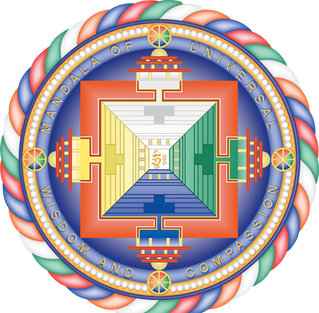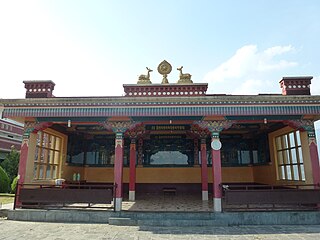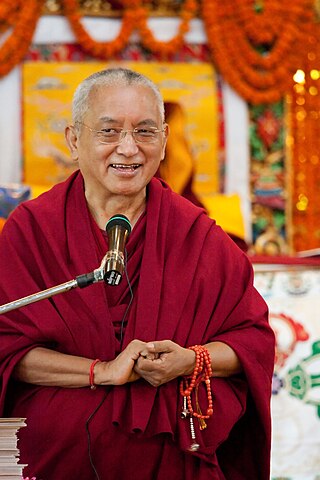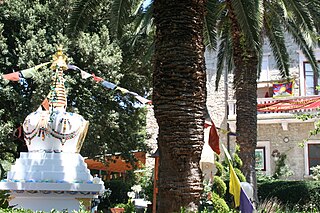| Part of a series on |
| Buddhism |
|---|
 |
Kwetsang Rinpoche was a lama of Sera who participated in the search for Tenzin Gyatso four years after Thubten Gyatso died. [1]
| Part of a series on |
| Buddhism |
|---|
 |
Kwetsang Rinpoche was a lama of Sera who participated in the search for Tenzin Gyatso four years after Thubten Gyatso died. [1]

Dalai Lama is a title given by the Tibetan people to the foremost spiritual leader of the Gelug or "Yellow Hat" school of Tibetan Buddhism, the newest and most dominant of the four major schools of Tibetan Buddhism. The 14th and incumbent Dalai Lama is Tenzin Gyatso, who lives in exile as a refugee in India. The Dalai Lama is also considered to be the successor in a line of tulkus who are believed to be incarnations of Avalokiteśvara, the Bodhisattva of Compassion.

Geshe Kelsang Gyatso was a Buddhist monk, meditation teacher, scholar, and author. He was the founder and spiritual director of the New Kadampa Tradition-International Kadampa Buddhist Union (NKT-IKBU), a registered non-profit, modern Buddhist organization that came out of the Gelugpa school/lineage. They have 1,300 centres around the world, including temples, city temples and retreat centres that offer an accessible approach to ancient wisdom.

Kelzang Gyatso, also spelled Kalzang Gyatso, Kelsang Gyatso and Kezang Gyatso, was the 7th Dalai Lama of Tibet, recognized as the true incarnation of the 6th Dalai Lama, and enthroned after a pretender was deposed.

The New Kadampa Tradition – International Kadampa Buddhist Union (NKT—IKBU) is a global Buddhist new religious movement founded by Kelsang Gyatso in England in 1991. In 2003 the words "International Kadampa Buddhist Union" (IKBU) were added to the original name "New Kadampa Tradition". The NKT-IKBU is an international organisation registered in England as a charitable, or non-profit, company. It currently lists more than 200 centres and around 900 branch classes/study groups in 40 countries. The BBC describe the New Kadampa Tradition as "one of the major Buddhist schools in the UK, founded by the Tibetan-born Geshe Kelsang Gyatso."

The Foundation for the Preservation of the Mahayana Tradition (FPMT) was founded in 1975 by Gelugpa Lamas Thubten Yeshe and Thubten Zopa Rinpoche, who began teaching Tibetan Buddhism to Western students in Nepal. The FPMT has grown to encompass over 138 dharma centers, projects, and services in 34 countries. Lama Yeshe led the organization until his death in 1984, followed by Lama Zopa until his death in 2023. The FPMT is now without a spiritual director; meetings on the organization's structure and future are planned.

Kopan Monastery is a Tibetan Buddhist monastery near Boudhanath, on the outskirts of Kathmandu, Nepal. It is a member of the Foundation for the Preservation of the Mahayana Tradition (FPMT), an international network of Gelugpa dharma centers, and once served as its headquarters.

Thubten Zopa Rinpoche was a Tibetan Buddhist lama in the Gelug school. He is known for founding the Foundation for the Preservation of the Mahayana Tradition and Maitripa College in Portland, Oregon.

Tenzin Ösel Hita y Torres is a Spanish Tibetan Buddhist tulku and an aspiring filmmaker. Born Ösel Hita Torres to María Torres and Francisco Hita, he was designated soon after his birth as the tulku or reincarnation of Thubten Yeshe—making him one of only a handful of Western tulkus—and renamed Tenzin Ösel Rinpoche.(Tibetan: བསྟན་འཛིན་འོད་གསལ་རིན་པོ་ཆེ།)
Lhundub Sopa was a Tibetan monk.
Thubten Gyatso is an Australian monk and was ordained by Lama Thubten Yeshe in the 1970s and was one of the first Westerners to become a monk in the Gelug school of Tibetan Buddhism. He is a Foundation for the Preservation of the Mahayana Tradition veteran who has been instrumental in establishing a number of Dharma centres in France, Taiwan, Australia, and Mongolia.
Thubten Shedrup Ling is the first Tibetan Buddhist monastery in Australia. It is located near Bendigo, Victoria, and is a member of the International Mahayana Institute of the Foundation for the Preservation of the Mahayana Tradition (FPMT).
Nicholas Ribush was one of the first Westerners to be ordained as a monk in the Tibetan Buddhist tradition. A founder of Wisdom Publications, Ribush is today the director of the Lama Yeshe Wisdom Archive, a collection of thousands of teachings by Lama Yeshe and Lama Zopa Rinpoche, who pioneered the teaching of Tibetan Buddhism in the West.
This is a list of topics related to Tibet.

The Istituto Lama Tzong Khapa (ILTK) in Pomaia, a village in Tuscany, in Italy (40 km south of Pisa) is a branch of the Foundation for the Preservation of the Mahayana Tradition (FPMT), an international network of Gelugpa dharma centers. It is named for Tsongkhapa, founder of the Gelugpa monastic order of Tibetan Buddhism. The Dalai Lama has taught there on several occasions.
Manjushri Institute was a large Buddhist college situated at Conishead Priory in Cumbria, England from 1976 until its dissolution in 1991. In 1991 its assets, including Conishead Priory, were transferred to a new centre on the same premises, Manjushri Mahayana Buddhist Centre, which was later renamed Manjushri Kadampa Meditation Centre.

10 Questions For The Dalai Lama is a 2006 documentary film in which filmmaker Rick Ray meets with Tenzin Gyatso, the 14th Dalai Lama at his monastery in Dharamsala, India. The film maker asks him ten questions during the course of the interview which is inter-cut with a biography of Tenzin Gyatso, a history of modern Tibet and a chronicle of Ray's journey securing the interview.
Khensur Denma Locho Rinpoche also known as Lobsang Oser Choying Gyatso, was a Tibetan incarnate lama, or tulku, of the Loseling College of Drepung Monastery. An expert on Yamantaka and Vajrayogini, he is considered an incomparable luminary of Je Tsongkhapa's lineage, is renowned as a holder of the Tantric lineages, a master of the Tantric yogas, and the lineage holder of Ling Rinpoche.

Sonam Wangyal is a former Indian paramilitary personnel and mountaineer who climbed Mount Everest in 1965 at the age 23, making him the youngest summiter. He was one of the nine summiters of the first successful Indian Everest Expeditions that climbed Mount Everest in May 1965 led by Captain M S Kohli,. He is the 3rd Indian man, and 18th man in world, to have climbed Mount Everest. On 22 May 1965, the first time that the oldest and the youngest climbed Everest together.

Sonam Gyatso (1923–1968) was an Indian mountaineer. He was the 2nd Indian man, the 17th man in world and first person from Sikkim to summit Mount Everest, the highest peak in the world. He was one of the nine summiters of the first successful Indian Everest Expeditions that climbed Mount Everest in May 1965 led by Captain M S Kohli. The first time that the oldest man at the time, Sonam Gyatso at age 42, and the youngest man Sonam Wangyal at age 23, climbed Everest together on 22 May 1965. He became the oldest person to scale the peak in 1965 and when he spent 50 minutes at the peak, he set a world record for spending the longest time at the highest point on Earth. The Government of India awarded him the third highest honour of the Padma Bhushan, in 1965, for his contributions to the sport of mountaineering.